
Headless CMS scales and improves WPWhiteBoard’s content distribution, flexibility, and personalization
What is AWS? It's a secure cloud platform that cuts costs, boosts speed, and unlocks innovation. Learn how Amazon Web Services helps you move faster and scale with confidence.
Type
Infrastructure
Founded
2006
Website
aws.amazon.com
Technology / What is AWS? A Straight-Talk Guide for Business Le…

You have a brilliant vision for your company's future. You are ready to scale, innovate, and deliver incredible customer value.
But a nagging friction slows you down: your technology infrastructure. The servers are expensive, the uptime is a constant worry, and the whole system feels more like a bottleneck than an accelerator.
When a great opportunity arises—a traffic spike from a marketing win or a chance to deploy a new feature—the first thought isn't "How fast can we go?" but "Can our hardware even handle it?"
Leaders like you have been shackled to the slow, expensive, and rigid world of on-premise hardware for years.
Break free. Access virtually unlimited computing power, storage, and cutting-edge technology on demand, paying only for what you use.
That is Amazon Web Services (AWS).
This is not a technical manual. It is a strategic guide written for you. We will go beyond the jargon to show you not just what AWS is, but why it is the engine of growth for millions of businesses.
Amazon Web Services (AWS) is a massive, secure, and comprehensive cloud computing platform. But what does "cloud computing" actually mean for your business?
This directly answers the question, Is AWS a cloud computing platform? Yes, it is the largest and most widely adopted one on the planet. Think of it as a utility, like the electric grid.
This is the simplest way to understand what is AWS and how it works: it provides the fundamental building blocks of IT on demand.
The platform is built on a few basic concepts of AWS:

This is the powerful answer to the question every leader has about Amazon Web Service price and cost—you only pay for what you use, transforming your cost structure from a fixed capital expense to a flexible operating expense.
To truly grasp the strategic importance of Amazon Web Services, we first need to understand the fundamental problem it solves.
For decades, running any kind of digital business meant you also had to be in the business of managing physical hardware. The two were inseparable. You had to own the "factory" just to produce your digital goods.
AWS fundamentally changed this paradigm.
Think about what it traditionally takes to launch a new application or scale an existing website. You must start by guessing your peak capacity needs. How many users will you have on your busiest day?
You buy expensive servers, storage arrays, and networking gear to meet that peak demand. This process is slow, requiring lengthy procurement cycles and significant capital expenditure.
The costs do not stop there. You need a physical space—a server room or a data center—with specialized power and cooling.
You need a team of engineers to rack the servers, manage the network, replace failed components, and patch the software.
This model is not just expensive; it is incredibly inefficient. Most of that powerful hardware you paid for sits idle, waiting for a traffic spike that might only happen a few times a year.
Your resources are locked in, your ability to experiment is slow, and your budget is consumed by keeping the lights on rather than driving innovation.
AWS flips that model on its head. Instead of owning the factory, you get on-demand access to a global, state-of-the-art one.
But for the other 364 days, most of those trucks sit idle in a garage, yet you are still paying for their insurance, maintenance, and storage.
Using AWS is like using a logistics-as-a-service partner like FedEx or UPS. You do not own any trucks. On a slow Tuesday, you pay for one van.
When Black Friday hits, you can instantly access a massive fleet of trucks and drivers, but you only pay for them for that specific day. When demand drops, you simply stop paying for the extra capacity.
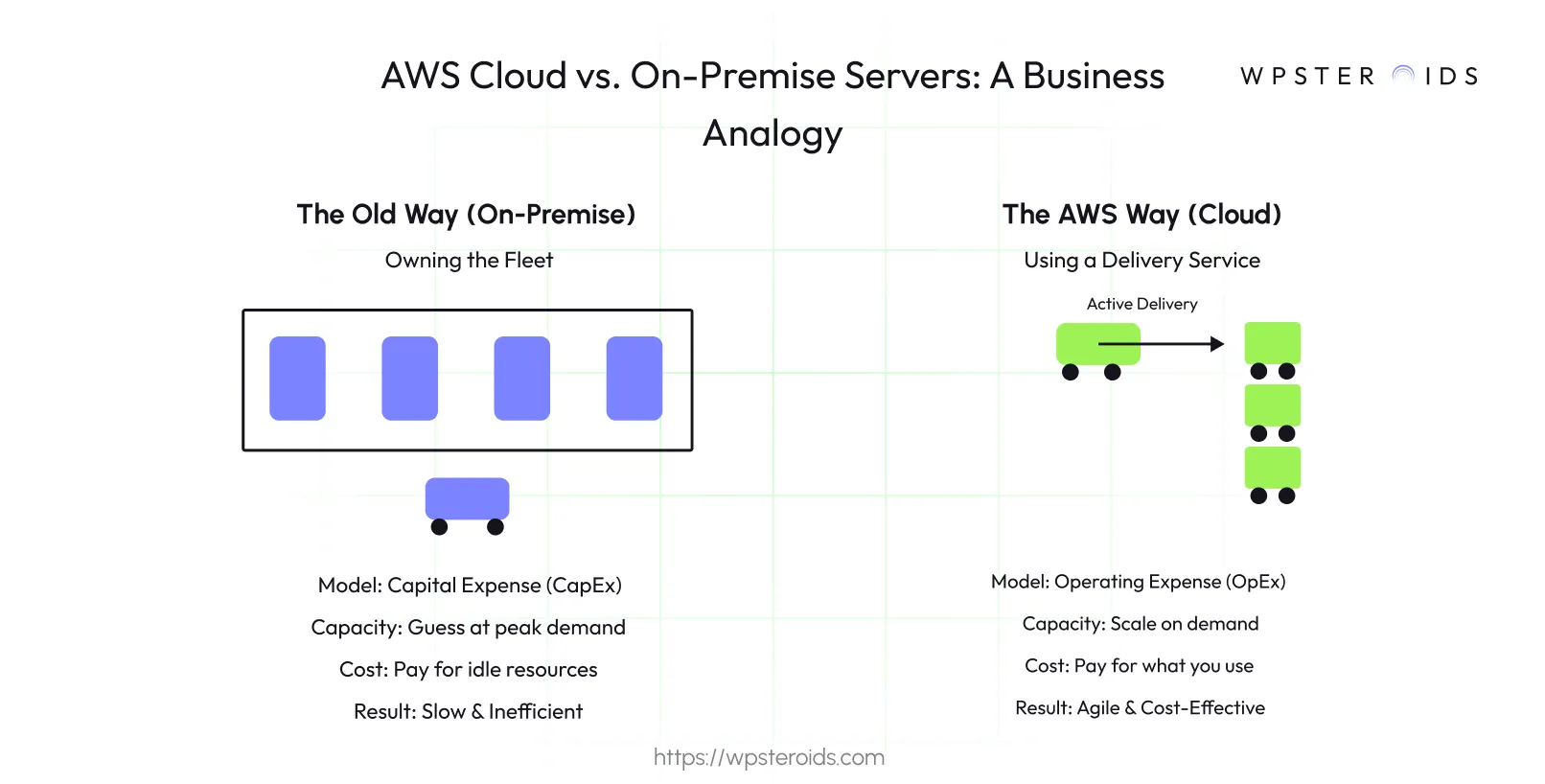
This is the essence of the Amazon Web Services (AWS) cloud platform. It transforms a massive capital expense (CapEx) into a predictable operating expense (OpEx).
When you are done, you turn them off and stop paying. This pay-as-you-go model frees up capital and, more importantly, empowers your teams to innovate at a speed that was previously unimaginable.
To understand why Amazon Web Services leads the market, you must know its origin. It wasn’t a product conceived in a boardroom; it was forged from necessity inside Amazon.com.
In the early 2000s, Amazon's explosive growth was being choked by its slow, expensive, and rigid internal infrastructure.
To survive, their engineers built a suite of standardized, on-demand services for their own teams, abstracting away the complexity of managing physical hardware.
The stroke of genius was realizing this powerful internal tool could solve the same problems for every other company.
What’s crucial for you as a leader to understand is that this history gives AWS a multi-year head start on every competitor.
They have been solving infrastructure problems at a massive scale for longer than anyone because they were their own first and most demanding customer.
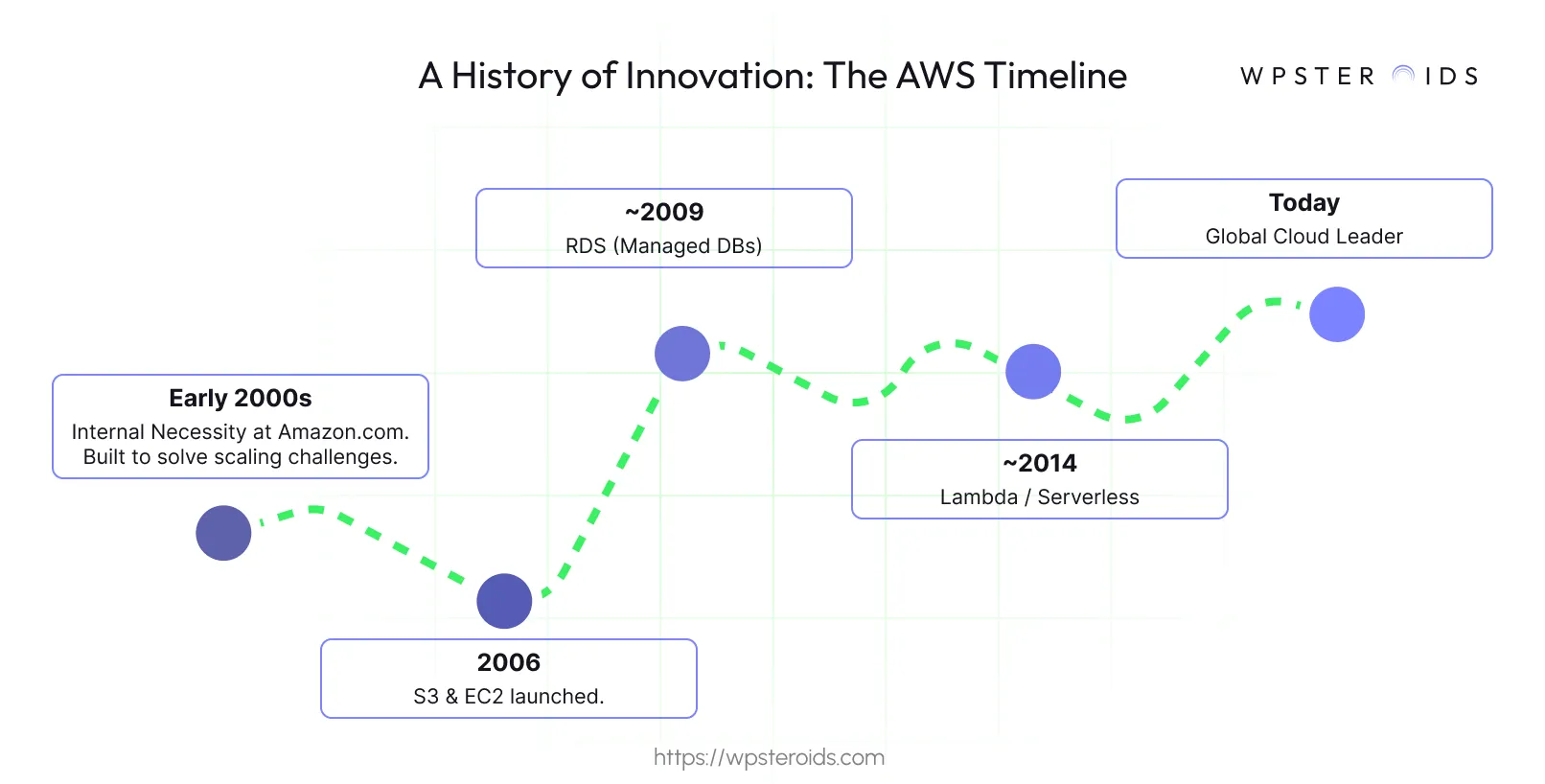
This fundamental shift from owning to renting the factory unlocks game-changing advantages. So why have millions of companies, including your competitors, made AWS the backbone of their operations?
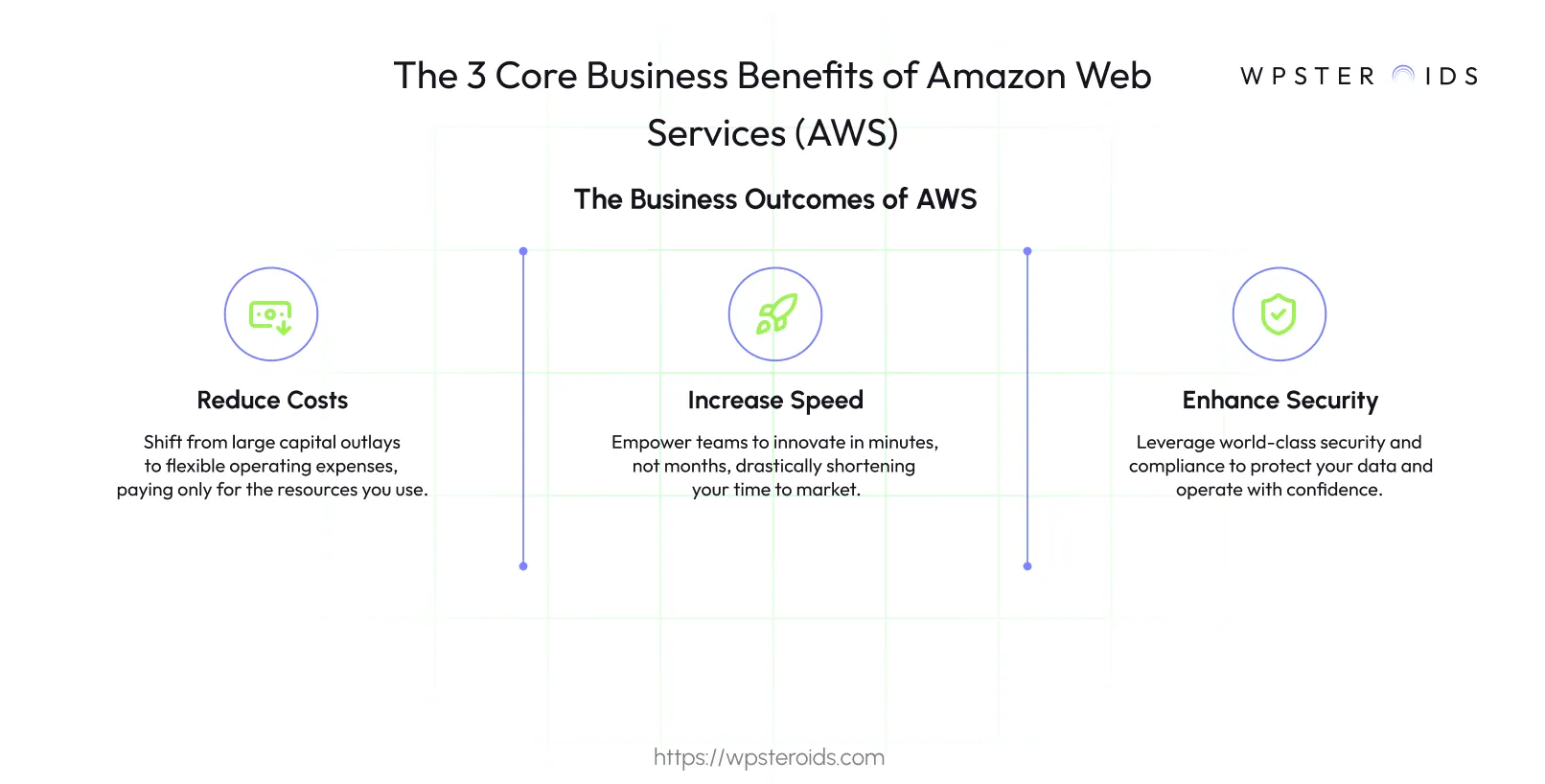
The answer is not about the technology itself. It is about the business outcomes it enables. For a strategic leader, the benefits of using AWS can be distilled into three critical areas:
The most immediate and tangible benefit of moving to AWS is the dramatic shift in your financial model.
The days of writing massive checks for servers you might need one day are over. By trading capital expenses (CapEx) for operating expenses (OpEx), you unlock a new level of financial agility.
The AWS cost structure is designed for efficiency. With its pay-as-you-go model, you are billed only for the services you consume, and you stop paying the second you turn them off. This eliminates the waste of paying for idle resources.
According to a 2024 Gartner report, worldwide end-user spending on public cloud services is forecast to grow 21.5% to total $723.4 billion in 2025.
This means that managing your AWS pricing and cost is not just a technical task; it is a strategic financial discipline.
You gain unprecedented visibility into where your money is going and can directly tie infrastructure spending to specific products and business value, making smarter, data-driven financial decisions.
In today's market, speed is a competitive advantage. The ability to conceive, build, and deploy a new idea faster than your rivals is what separates market leaders from followers.
This is where AWS truly transforms your organization's potential.
This removes the friction from innovation. It creates an environment where experimentation is encouraged because the cost of failure is negligible.
If a new idea does not work, you simply decommission the resources. No harm, no foul, and no expensive hardware gathering dust.
By leveraging higher-level services, you offload the "undifferentiated heavy lifting" of managing infrastructure, operating systems, and databases. This approach frees your most valuable and expensive resource: your engineering talent.
Instead of spending their days patching servers, they can focus their creative energy on building the features that will delight your customers and grow your bottom line.
For a leader, worries about scalability and security are what keep you up at night. Will the website crash during our biggest sales event? Is our customer data truly secure? AWS is designed to alleviate these core anxieties.
This means you can confidently handle a massive, unexpected traffic spike from a viral marketing campaign just as easily as you handle a quiet Tuesday morning. You get the performance you need, precisely when you need it, without manual intervention.
Security on AWS is a shared responsibility, but Amazon takes on the heaviest burden. AWS has a world-class team of security experts and invests billions in securing its global data centers—a level of physical and operational security that most individual companies could never hope to achieve.
AWS secures the cloud; you are responsible for securing what you put in the cloud. This partnership allows you to build and operate with a level of confidence and peace of mind that is simply unattainable in a traditional on-premise world.
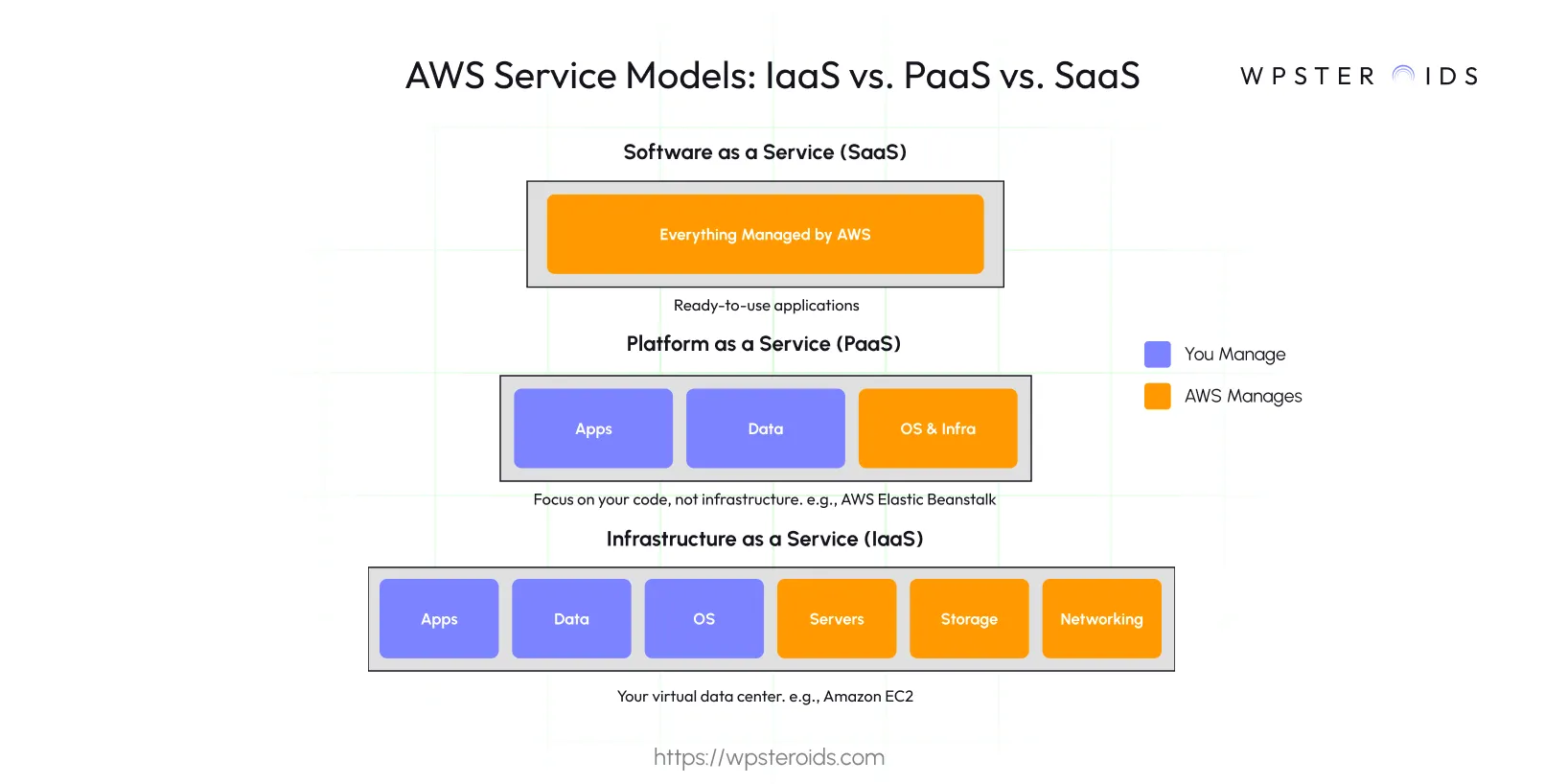
How does AWS deliver these transformative benefits? It does so through a flexible set of service models that allow you to choose the right balance of control and convenience.
To understand AWS, you only need to grasp the three main service categories it provides:
IaaS is the foundational layer of the cloud. With AWS IaaS, you are essentially renting the fundamental building blocks of computing: servers, storage, and networking.
PaaS is the next level of abstraction. With this model, you do not have to manage the underlying infrastructure or the operating system. Your team can focus purely on writing code.
SaaS is the model most people are familiar with, as we use it every day. It is a completed software product that is managed by the provider and delivered over the internet.
At this point, you might be thinking, "This sounds powerful, but it also sounds complicated". Many resources list this "steep learning curve" as a primary disadvantage of AWS.
But this perspective reframes this common objection into a core strategic advantage. The perceived complexity of AWS is not a flaw; it is a direct reflection of its immense capability.
Think of it this way: a simple tool can solve a simple problem. A hammer is great for nails. But what if you need to build an entire house? You do not need a hammer; you need a complete workshop filled with specialized tools.
AWS is that complete workshop. A simple platform can host a simple website. But a platform designed to solve nearly any business challenge—from global e-commerce to AI applications—will naturally have a comprehensive set of tools.
Your job is not to master every tool personally. Your job is to ensure your engineering teams have a workshop with every tool they could possibly need, both for today's projects and for the innovations of tomorrow.
When you see the vast catalog of AWS services, do not see complexity. See the possibility. See a platform with the strategic depth to support any future vision.
That is not a disadvantage; it is your competitive edge.
No technology is poised to reshape the business landscape more than Artificial Intelligence. For many leaders, however, AI can feel abstract and out of reach, requiring specialized expertise and massive computational power.
AWS is the single greatest accelerator for making AI a practical reality for your business. It provides a complete, end-to-end stack of services that allows companies of any size to build, train, and deploy sophisticated AI applications at scale.
AI, particularly deep learning and generative AI, is computationally hungry. Training a modern AI model requires a staggering amount of processing power that is simply not feasible to own and manage in-house. AWS provides this foundational layer on demand.
This starts with GPU-enabled EC2 instances. These are virtual servers supercharged with powerful NVIDIA GPUs, the industry standard for AI model training. But AWS has gone a step further by designing its own custom silicon.
AWS Trainium chips are purpose-built to provide the most cost-effective performance for training machine learning models, while AWS Inferentia chips are optimized to deliver high-performance, low-cost predictions (or "inference") once a model is deployed.
For you as a leader, this means you get access to the best and most cost-effective hardware for any AI job without the massive capital outlay. You can rent an AI supercomputer for an afternoon, run your training job, and then turn it off.
Having raw power is one thing, but making it productive for your data science and development teams is another. This is where Amazon SageMaker comes in.
SageMaker is a fully managed platform that simplifies and accelerates the entire machine learning lifecycle.
Think of it as the ultimate workbench for your AI builders. It provides a single environment where they can connect to data sources, build and train models, fine-tune them for performance, and deploy them into production with just a few clicks.
It removes the undifferentiated heavy lifting of managing servers, software versions, and complex workflows.
This allows your team to spend less time on infrastructure plumbing and more time on the high-value work of building models that can predict customer churn, optimize supply chains, or create new user experiences.
What if you don't have a team of data scientists? This is perhaps the most powerful part of the AWS AI stack. AWS offers a suite of pre-trained AI services that any developer can integrate into their applications through a simple API call.
You don't need to know anything about machine learning to use them. You can add powerful capabilities to your products instantly:
These services democratize AI. They allow you to add a layer of intelligence to your existing applications quickly and affordably, enabling you to innovate and create smarter customer experiences without needing deep ML expertise on staff.
From foundational hardware to developer workbenches and simple APIs, AWS provides a complete toolkit to infuse intelligence into every corner of your business. Understanding these tools is the first step.
From foundational hardware to developer workbenches and simple APIs, AWS provides a complete toolkit to infuse intelligence into your business.
For any strategic leader, the conversation about a powerful new platform inevitably turns to cost. How much does it cost, and how do we control it?
The Amazon Web Services price structure is designed for flexibility and efficiency, but understanding how to leverage it is key to maximizing its value. This is where mastering cloud economics becomes a competitive advantage.
Unlike traditional software licensing, the AWS pricing and cost philosophy is built on a few core models. Understanding them allows you to match your spending to your workload patterns.
The dynamic nature of cloud spending requires a new approach to financial governance. This has led to the rise of FinOps, a cultural practice that brings your Finance, Technology, and Business teams together to manage cloud costs strategically.
AWS provides a suite of tools, like AWS Budgets and Cost Explorer, to give you granular visibility into your spending.
The goal is to stop thinking of Amazon Web Services cost as just another IT expense and start seeing it as a direct reflection of your business activity. Here, the delivery truck analogy perfectly illustrates the financial efficiency you unlock.
Using traditional on-premise servers is like owning a fleet of delivery trucks. You have to buy enough trucks to handle your busiest day of the year, like Black Friday.
But for the other 364 days, most of those trucks sit idle in a garage, yet you're still paying for their insurance, maintenance, and storage. This is a massive, inefficient capital expense.
Using AWS is like using a logistics-as-a-service partner. On a slow Tuesday, you pay for one van. When Black Friday hits, you can instantly access a massive fleet of trucks and drivers, but you only pay for them for that specific day.
When demand drops, you simply stop paying for the extra capacity.
This is the power of the pay-as-you-go model. It eliminates the crippling cost of idle resources and allows you to tightly align your spending with your actual business needs, turning your cost center into a highly efficient, strategic asset.
Theory is important, but value comes from execution. So, how do you actually start getting hands-on with AWS without getting lost in the details?
As a leader, your role isn't to configure the virtual servers yourself, but to set the strategy and create a plan that empowers your team to succeed.
This isn't about diving into the deep end; it's about building momentum through a series of smart, calculated steps.
Before your team writes a single line of code for a new application on AWS, it's critical to understand one of the most powerful concepts the cloud enables: Infrastructure as Code (IaC).
In the old world, when you needed a new server environment, someone would manually click through wizards, configure settings, and hope they didn't miss a step.
This process is slow, prone to human error, and nearly impossible to replicate perfectly every time.
This file acts as a blueprint. Need to deploy a new environment for testing? Run the blueprint. Need to deploy the same environment for production? Run the same blueprint.
This is a game-changer for a strategic leader. It means your deployments are:
Embracing automation from day one is the key to unlocking the speed and reliability that the AWS platform promises.
For leaders approaching this for the first time, this simple roadmap can serve as the essential "Amazon Web Services for Dummies" guide to getting started.
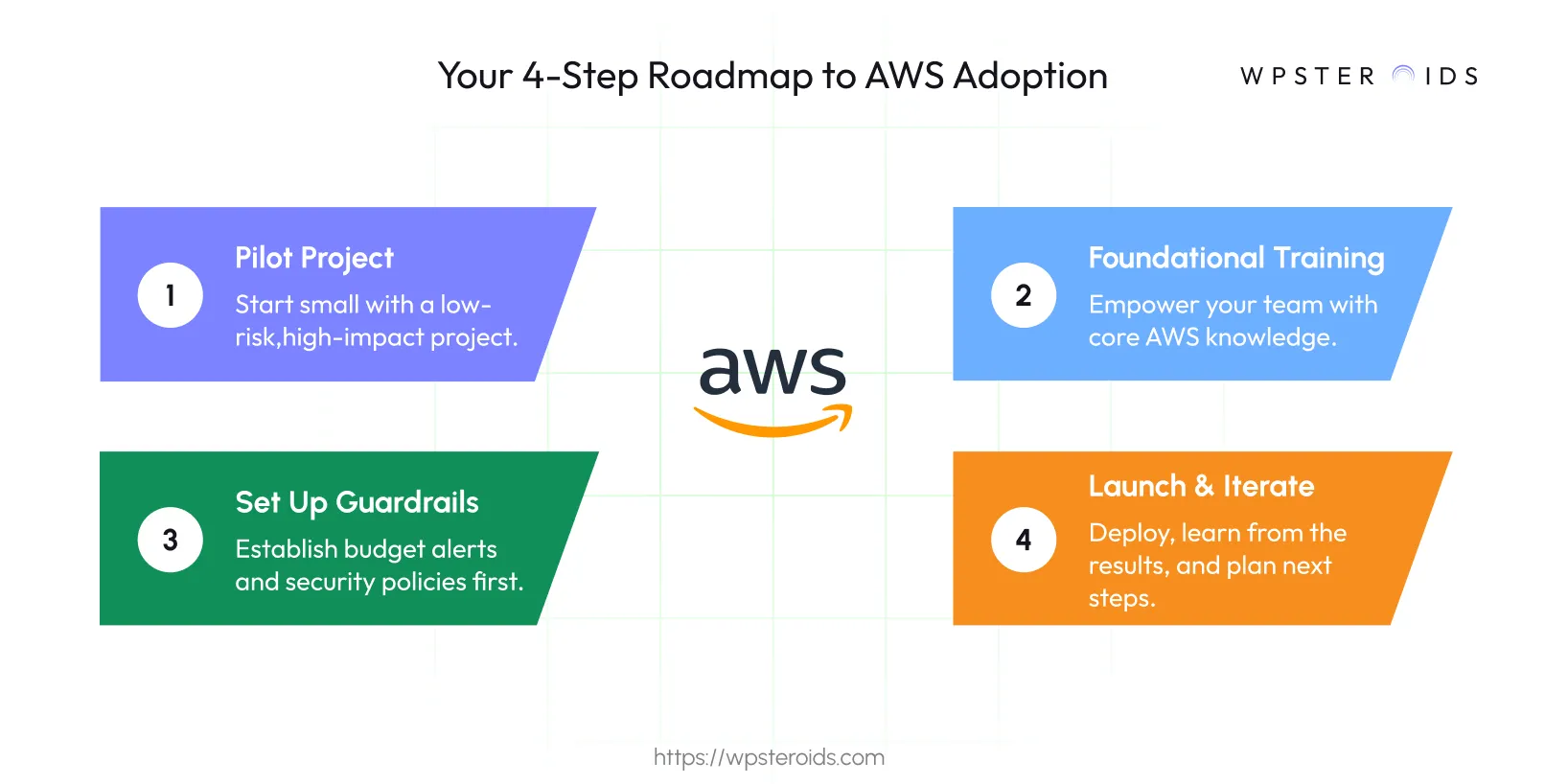
The goal is to learn and build confidence while minimizing risk.
Finally, as you get started, remember that you are not just adopting a static set of tools. You are investing in a platform that is constantly evolving.
A key way to understand the future direction of AWS is to look at where it's investing and what kinds of companies it's acquiring.
While specific acquisitions change year to year, the patterns reveal AWS's strategic priorities. In recent years, they have consistently invested in areas like:
You don't need to track every deal. But you should know that when you build on AWS, you're building on a platform that is aggressively acquiring and integrating the technologies that will define the future.
Your hands-on roadmap isn't just about solving today's problems; it's about positioning your company on a foundation that is already building the solutions for tomorrow's challenges.
We began with a simple question: What is AWS? It is a fundamental shift in how you build and run your business. It is the answer to the frustrations of slow, expensive, and rigid infrastructure.
Amazon Web Services is the platform that lets you stop worrying about servers and start focusing on your vision.
It provides the core business benefits that matter most to a leader:
You no longer have to own the factory. You have on-demand access to the best one in the world, allowing you to move faster, dream bigger, and build the future of your company without limits.
The next step is to start a conversation with your technical leaders. The journey may begin with a single workload, but it opens the door to a new era of agility and innovation for your entire organization.
Your infrastructure should be an accelerator, not an anchor. With AWS, it can be.
Discover how brands are fueling success with a MACH-based digital architecture.